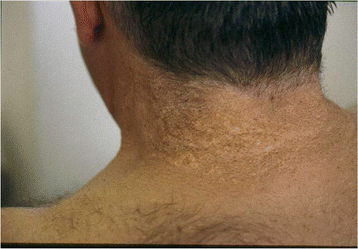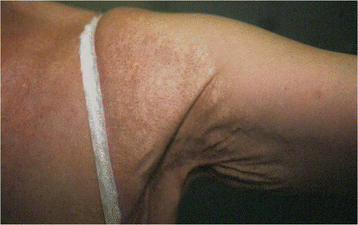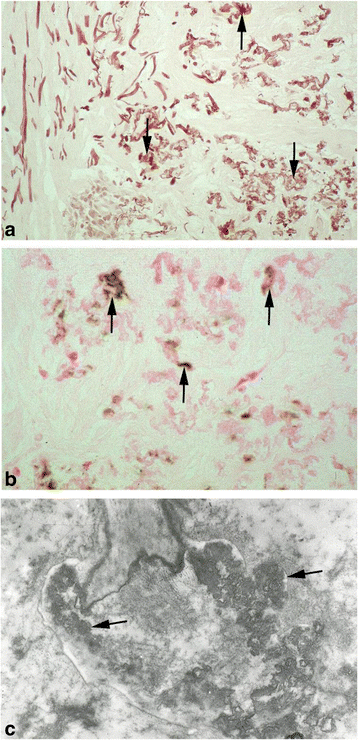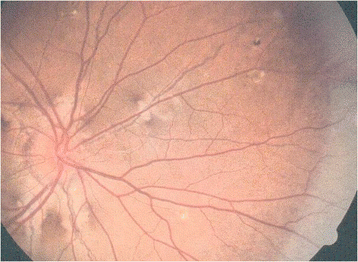Pseudoxanthoma elasticum
- PMID: 28486967
- PMCID: PMC5424392
- DOI: 10.1186/s13023-017-0639-8
Pseudoxanthoma elasticum
Abstract
Pseudoxanthoma elasticum (PXE) is a genetic metabolic disease with autosomal recessive inheritance caused by mutations in the ABCC6 gene. The lack of functional ABCC6 protein leads to ectopic mineralization that is most apparent in the elastic tissues of the skin, eyes and blood vessels. The clinical prevalence of PXE has been estimated at between 1 per 100,000 and 1 per 25,000, with slight female predominance. The first clinical sign of PXE is almost always small yellow papules on the nape and sides of the neck and in flexural areas. The papules coalesce, and the skin becomes loose and wrinkled. The mid-dermal elastic fibers are short, fragmented, clumped and calcified. Dystrophic calcification of Bruch's membrane, revealed by angioid streaks, may trigger choroidal neovascularization and, ultimately, loss of central vision and blindness in late-stage disease. Lesions in small and medium-sized artery walls may result in intermittent claudication and peripheral artery disease. Cardiac complications (myocardial infarction, angina pectoris) are thought to be relatively rare but merit thorough investigation. Ischemic strokes have been reported. PXE is a metabolic disease in which circulating levels of an anti-mineralization factor are low. There is good evidence to suggest that the factor is inorganic pyrophosphate (PPi), and that the circulating low levels of PPi and decreased PPi/Pi ratio result from the lack of ATP release by hepatocytes harboring the mutant ABCC6 protein. However, the substrate(s) bound, transported or modulated by the ABCC6 protein remain unknown. More than 300 sequence variants of the ABCC6 gene have been identified. There is no cure for PXE; the main symptomatic treatments are vascular endothelial growth factor inhibitor therapy (for ophthalmic manifestations), lifestyle, lipid-lowering and dietary measures (for reducing vascular risk factors), and vascular surgery (for severe cardiovascular manifestations). Future treatment options may include gene therapy/editing and pharmacologic chaperone therapy.
Keywords: ABCC6; Angioid streak; Choroidal neovascularization; Ectopic mineralization; Metabolic disease; Peripheral arterial disease; Pseudoxanthoma elasticum; Skin.
Figures




Similar articles
-
ABCC6 prevents ectopic mineralization seen in pseudoxanthoma elasticum by inducing cellular nucleotide release.Proc Natl Acad Sci U S A. 2013 Dec 10;110(50):20206-11. doi: 10.1073/pnas.1319582110. Epub 2013 Nov 25. Proc Natl Acad Sci U S A. 2013. PMID: 24277820 Free PMC article.
-
The ABCC6 Transporter: A New Player in Biomineralization.Int J Mol Sci. 2017 Sep 11;18(9):1941. doi: 10.3390/ijms18091941. Int J Mol Sci. 2017. PMID: 28891970 Free PMC article. Review.
-
Pseudoxanthoma elasticum - Genetics, pathophysiology, and clinical presentation.Prog Retin Eye Res. 2024 Sep;102:101274. doi: 10.1016/j.preteyeres.2024.101274. Epub 2024 May 28. Prog Retin Eye Res. 2024. PMID: 38815804 Review.
-
[Pseudoxanthoma elasticum].Ophthalmologe. 2006 Jun;103(6):537-51; quiz 552-3. doi: 10.1007/s00347-006-1353-4. Ophthalmologe. 2006. PMID: 16763870 Review. German.
-
Pyrophosphates as a major inhibitor of matrix calcification in Pseudoxanthoma elasticum.J Dermatol Sci. 2014 Aug;75(2):109-20. doi: 10.1016/j.jdermsci.2014.04.015. Epub 2014 May 17. J Dermatol Sci. 2014. PMID: 24907773
Cited by
-
Blau Syndrome: Challenging Molecular Genetic Diagnostics of Autoinflammatory Disease.Genes (Basel). 2024 Jun 18;15(6):799. doi: 10.3390/genes15060799. Genes (Basel). 2024. PMID: 38927735 Free PMC article.
-
Therapy of Pseudoxanthoma Elasticum: Current Knowledge and Future Perspectives.Biomedicines. 2021 Dec 13;9(12):1895. doi: 10.3390/biomedicines9121895. Biomedicines. 2021. PMID: 34944710 Free PMC article. Review.
-
Rare Neurovascular Diseases in Korea: Classification and Related Genetic Variants.Korean J Radiol. 2021 Aug;22(8):1379-1396. doi: 10.3348/kjr.2020.1171. Epub 2021 May 20. Korean J Radiol. 2021. PMID: 34047503 Free PMC article. Review.
-
Profile of genetic variations in severely calcified carotid plaques by whole-exome sequencing.Surg Neurol Int. 2020 Sep 12;11:286. doi: 10.25259/SNI_387_2020. eCollection 2020. Surg Neurol Int. 2020. PMID: 33033648 Free PMC article.
-
Pseudoxanthoma elasticum.Autops Case Rep. 2017 Dec 8;7(4):18-21. doi: 10.4322/acr.2017.035. eCollection 2017 Oct-Dec. Autops Case Rep. 2017. PMID: 29259928 Free PMC article. No abstract available.
References
-
- Darier J. Pseudoxanthoma elasticum. Monatshefte Prakt Derm. 1896;23:609–17.
-
- Rigal D. Observation pour servir à l’histoire de la cheloide diffuse xanthelasmique. Ann Dermatol Syph (Paris) 1881;2:491–501.
-
- Gronblad E. Angioid streaks - pseudoxanthoma elasticum. Acta Ophthal. 1929;7:329. doi: 10.1111/j.1755-3768.1929.tb07934.x. - DOI
-
- Strandberg J. Pseudoxanthoma elasticum. Z Haut Geschlechtskr. 1929;31:689.
Publication types
MeSH terms
Substances
LinkOut - more resources
Full Text Sources
Other Literature Sources
Research Materials
Miscellaneous

